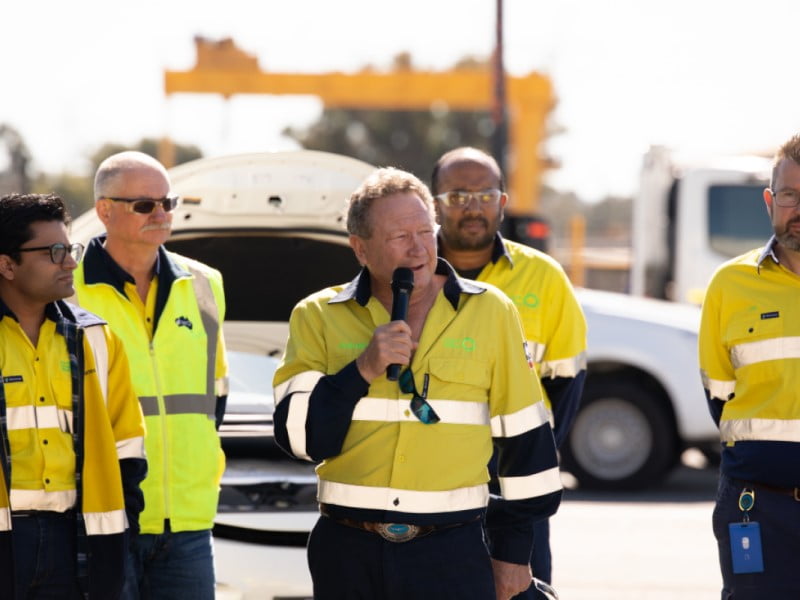Fortescue will manufacture electrolysers developed in-house at its $114 million production facility being developed in Gladstone following the collapse of its partnership with US-based supplier Plug Power.
Although Plug Power Electrolysers will not be produced from the facility, they may still be supplied to other Fortescue projects, according to Fortescue Future Industries (FFI) chief executive Mark Hutchinson.
Plug Power informed investors of its withdrawal from the Green Energy Manufacturing Centre in a business update conference call on Thursday.
According to the Australian Financial Review, Plug Power chief executive Andrew Marsh told investors “it didn’t want to build a factory with them [Fortescue] because we saw the economics”.
However, Fortescue told analysts and members of the press during a teleconference on Friday that the joint venture ended because it was seeking greater independence over its supply chain.
Mr Hutchinson claimed the end of the joint venture was motivated by the Australian firm’s desire to “control our own destiny” and produce electrolyser technologies it owned the IP for.
Construction began on the production facility in February 2022. It is on track to be operational by the end of this year, according to Fortescue founder Andrew Forrest.
FFI wants to produce 15 million tonnes of green hydrogen annually by 2030, and will use the facility to manufacture both alkaline and proton exchange membrane electrolysers.

Previously a 50-50 joint venture with Plug Power, the $114 million Gladstone facility is expected to initially produce 2GW worth of electrolysers annually, the equivalent capacity for producing 50,000 tonnes of hydrogen.
Plug Power’s chief executive told investors that he didn’t think the joint venture was “worthwhile to move ahead” but reiterated that the firm would continue to work with Fortescue on electrolysers, according to the AFR.
“There is no better green hydrogen plant folks in the US than us, so we really don’t need a lot of help,” Mr Marsh said.
Fortescue founder and executive chair Andrew Forrest claimed “we always expected to cover the total cost” of the Gladstone facility before deferring to Mr Hutchinson who said that the total capital expenditure will not change.
Mr Hutchinson said FFI has been “developing technology on PEM and alkaline for some time”. He also claimed that the production of Fortescue’s electrolyser technology will reach a much larger scale than if it used Plug Power’s.
“The feeling really was that we were advanced on our own technology, the IP was ours, we can do it at scale. I think Plug Power is very much locked into a certain technology and on a production cycle, and what we’re good at here is building things at scale and it’s exactly what we’re going to do on the electrolyser side,” Mr Hutchinson said.
“The facility in Gladstone is going ahead as planned, nothing changes. What the exciting thing is, it’s going to be Australian technology, and we’re going to do that on time. It’s going to be our own technology, and that’s been developed very, very well.”
Mr Forrest added that Fortescue’s international research partnerships, such as with the United Sates’ National Renewable Energy Laboratory, gives the firm “serious transparency into the cutting edge of what electrolysers and green technologies are doing”.
At the time of the joint venture’s announcement in October 2021, Plug Power also announced it would sell 250MW of electrolysers to Fortescue, as a part of the agreement.
News of Plug Power’s withdrawal from the Gladstone project follows Tuesday’s announcement that FFI had signed a memorandum of understanding with zero emissions vehicle manufacturer Nikola Corporation “to collaborate on and evaluate the co-development of large-scale US green hydrogen production facilities”.
This included a commitment from Nikola to “evaluate green hydrogen offtake opportunities from any other green hydrogen projects being pursued by FFI”, according to the US-based firm.
The Inflation Reduction Act (IRA), which includes generous tax credits for hydrogen production and renewable infrastructure has been criticised for unfairly advantaging businesses in the US. This included a consultation submission from the Australian government to the US seeking assurances that the IRA would not cause “distortion in the global hydrogen market”.
During Friday’s teleconference, Mr Forrest said in part due to the IRA, “the last 10 months has seen an unprecedented acceleration of the green energy transition”.
“The IRA in the US is stimulating private investment in green energy and its making it the greatest place in the world to invest,” he said.
The European Union announced last week that it would legislate a Net-Zero Industry Act that aims to focus investment in strategic areas across the CleanTech supply chain as well as to fast track projects.
Do you know more? Contact James Riley via Email.

